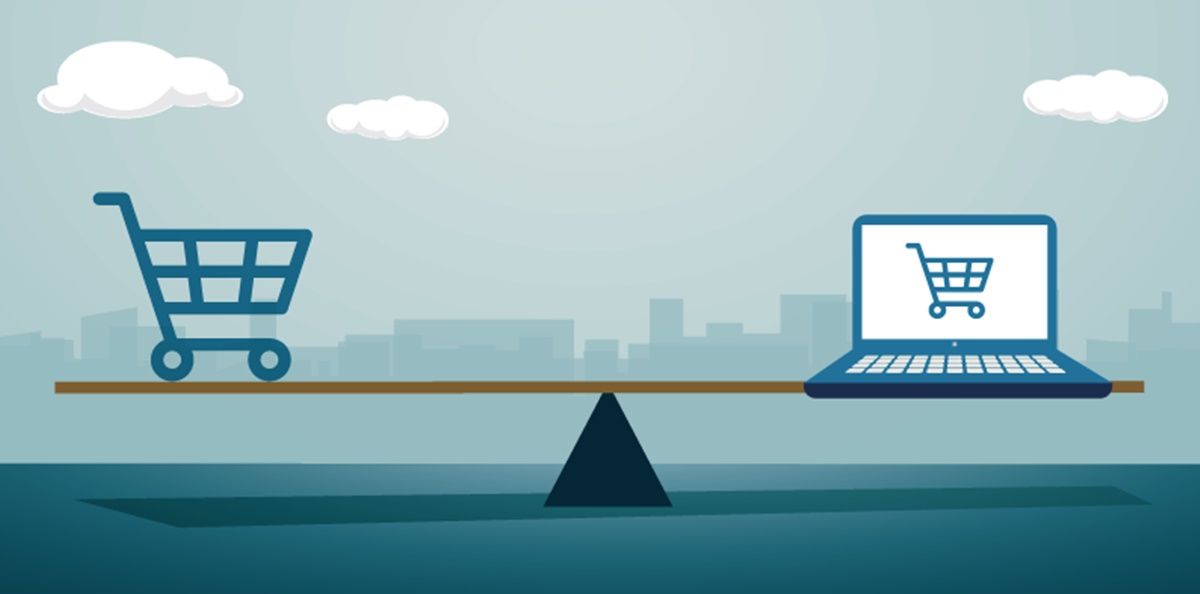What is E-commerce? Everything You Need to Know!
In the midst of the Internet Revolution, E-commerce has been developing as a monster industry. In 2019, global retail eCommerce sales amounted to $3.5 trillion, and this figure is continuously on the rise. The new method of shopping is seriously threatening traditional stores!
However, it doesn’t necessarily mean eCommerce has reached its peak already. A report shows that an average of 2.86% eCommerce website visits convert into purchases. Hence, there is more than enough room for improvement in this area.
Any savvy entrepreneurs diving into the eCommerce world have a lot of things to learn about this industry. In this guide, we’re going to mention all essential E-commerce basics.
Let’s take a look!
What is E-commerce?
Electronic commerce or internet commerce, commonly known as E-commerce, involves the buying and selling of goods or services over the Internet, and the transfer of data and money to execute these transactions. E-commerce can also entail other types of activities, such as internet banking, online auctions, online ticketing, and payment gateways.
Most businesses with an e-commerce presence set up an e-commerce store or use an e-commerce platform, not only to conduct online marketing and sales activities but also to oversee logistics and fulfillment.

Due to the expanding market, the influence of wireless handheld devices (e.g. smartphones, tablets), as well as millennials’ comfort with online shopping, m-commerce, or mobile commerce activity, is on the rise. In 2018, this increasingly large subset of E-commerce enjoyed a 39.1% increase in sales compared to the previous year and has been expected to skyrocket in the next few years.
A brief history of E-commerce
The history of E-commerce dates back further than you might think. It initially emerged about 40 years ago in its earliest form.
In 1979, Michael Aldrich created the foundation of E-commerce by connecting his television to a computer using the telephone line. Although it was not the same as E-commerce we know today, his idea sparked something about shopping without visiting a brick-and-mortar store.
Not until August 11, 1994, did the first online sale happen. A man named Phil Brandenberger used his Mastercard and bought the compact disk “Ten Summoners’ Tales” by the rock musician Sting via the Internet for $12.48. This special transaction made history and spoke to the world that the Internet is widely open for E-commerce transactions.

Needless to say, the rise of E-commerce giants like Alibaba and Amazon in the mid-90s entirely changed the retail industry’s face. They mostly took advantage of the global internet penetration and digitalization of the financial system to make money. This change contributed a lot to the decline in sales for many traditional businesses.
The impressive growth of E-commerce has also shifted the retail workforce. From 1997 to 2016, the U.S Bureau of Labour Statistics (BLS) has revealed that employment in the E-commerce sector increased by about 80%. Also, the number of jobs related to E-commerce in the US is predicted to keep on growing and reach 450,000 by 2026.
From its very first beginning till now, E-commerce has evolved to make goods and services more accessible to discover and purchase through online marketplaces and retailers. In addition to traditional offline stores, many small businesses and large corporations are promoting their online presence to approach and satisfy as many customers as possible.
Before jumping into the next sections, we want to remind you that there are many ways to classify E-commerce. In this guide, we will categorize E-commerce according to:
- E-commerce business models (the parties involved in E-commerce transactions)
- E-commerce websites (the types of products or services)
- E-commerce platforms
4 common types of E-commerce business models
When it comes to transactions between businesses and consumers, there are typically 4 main types of E-commerce business models. Let’s see what they are and how they differ from each other!
Business to business (B2B)
The B2B, business to business model, involves providing goods and services between one business and another business. While many businesses in this model are service providers, you can find software companies, document hosting companies, office furniture and supply organizations, and numerous other E-commerce businesses under this heading.
Alibaba is a typical example of a B2B business, and its wholesale prices allow other businesses to profit from their products. Normally B2B companies offer a discounted rate per unit if customers buy in bulk, which is an excellent motivation for businesses to avail of.
Related topic: B2B Sales: What it is? Strategies and more
Business to consumer (B2C)
The B2C, business to consumer model, is what most people think of when talking about an E-commerce business. This is the most extensive and most in-depth market, which occurs when a business sells a good or service to an individual consumer. If you decide to open your own retail store, you will likely be selling to customers instead of businesses.

A familiar example of this model would be supermarkets where buyers do their shopping weekly, but they wouldn’t purchase an enormous large number of products at once. Amazon, Walmart, and Apple are examples of the B2C model.
Read more: What is B2B and B2C? Differences between B2B and B2C
Consumer to consumer (C2C)
B2B and B2C seem intuitive concepts for most of us, but the idea of C2C is quite different. So, what does a consumer-to-consumer E-commerce business look like?
Developed by the rise of the E-commerce sector, and growing consumer confidence in online business, this model allows customers to buy, sell, and trade items to other customers. For instance, you sell your old bicycle on eBay to another consumer.
Some other examples of a C2C business model are Craigslist, Facebook Marketplace, and Kijiji. Many sellers on these sites are not businesses; they are just normal consumers selling products they own, whether new or second-hand.
Consumer to business (C2B)
The C2B model, consumer to business, is another thing that most people don’t immediately think of, but it is growing in popularity. This online commerce business happens when a consumer sells his/ her products or services to an organization or a business.
For example, a photographer licenses their photos for a business to use, or bloggers who sell advertising space on their websites are also participating in a C2B transaction.
4 common types of E-commerce websites
After you understand different types of E-commerce business models based on the parties that they transact with, you should know how to classify E-commerce businesses according to what they sell.
Physical goods E-commerce website
Clothing, furniture, accessories, and tools are all examples of physical goods sold on E-commerce websites. Shoppers can buy physical goods through E-commerce stores by browsing the store’s website, adding items in their shopping cart, and making a purchase.
Once buyers have done, the store receives their information and delivers the items right at their doorstep. There are also online shops where customers can make an online purchase but go to the physical store to pick up the products themselves.
Some retailers who are running brick-and-mortar businesses can host their stores online to reach a broader audience. This option is great for promoting both sales and brand awareness.
Service-based E-commerce website
Aside from physical products, services can also be transacted online. Every time you hire freelancers, educators, and consultants through online platforms, you’re doing business with service-based E-commerce websites.
The buying process for these websites depends on the service providers. Some may enable you to purchase their services right away from their platform or website. For instance, people who want to buy from Fiverr.com - a freelance marketplace must place an order on the website before the seller delivers their services.
On the other hand, some will require you to connect with them first to determine your needs. Take Blue Fountain Media as an example. The company develops digital strategies for large businesses, asks their clients to get in touch with them by filling in an online form, in which they should describe their business needs.
Digital products E-commerce website
The phrase “digital products” refers to all items in a digital format, including software, ebooks, online courses, graphics, video games, and virtual goods. This type of E-commerce business doesn’t need physical stores, as it mostly involves customers downloading the products.

Examples of companies that sell digital products are Coursera (a website for online learning) and Audiobooks (a platform where you can purchase audiobooks).
Dropshipping E-commerce website
Dropshipping takes place when merchants sell goods to customers on their online website, but they don’t need to hold any inventory. Instead, they find a supplier, wait for customers to place orders, send all information about the orders to the supplier. Then customers will receive the orders directly from the supplier.
Read more: What is dropshipping?
Some dropshipping websites are well-known among dropshippers for their usefulness and professional working styles, such as AliExpress, Chinabrands, Wholesale2B, and so on. You can read this blog to know more about the top 12 best dropshipping websites.
You might be interested in:
- How Does Dropshipping Work on Shopify?
- How to Find a Profitable Niche for Dropshipping
- Top 41+ Best Dropshipping Products to Sell
- 22 Best Dropshipping Suppliers in the USA
- Is Dropshipping Dead?
What is an E-commerce platform?
We’ve talked about the types of E-commerce business models, as well as the products and services sold online. But the question is, where and how do these transactions take place?
The answer is, it varies.
In this section, we’d like to shed light on some of the most common platforms where E-commerce activities occur.
First and foremost, what is an E-commerce platform? Simply put, an E-commerce platform refers to a software solution that enables businesses to create and adjust their online stores. By using these platforms, businesses can sell goods and services to people worldwide, making use of delivery services to transport products to customers.
You can see the percentage of some of the most popular E-commerce platforms in the visual representation below.

So, the following are the 4 best E-commerce solutions currently on the market.
WooCommerce
Here are some facts about WooCommerce:
- WooCommerce has been currently powering over 3,317,205 live websites.
- 22% of the top 1 million E-commerce websites use WooCommerce.
WooCommerce is one of the largest open-source and fully customizable E-commerce platforms for entrepreneurs all over the world. Perfectly designed to integrate with Wordpress, WooCommerce has a wide range of templates that can help you set up a unique online store. You’ll get all the necessary features, including unrestricted customization, unlimited products, order management, and free shipping.
Best for Small and medium businesses that have a website powered by Wordpress.
Learn more: WooCommerce vs. Shopify: The Comprehensive Guide for you to Choose the Right Platform
Magento
Here are some facts about Magento:
- Magento has been currently powering over 772,000 websites around the globe.
- There are more than 5,900 extensions that integrate with Magento.
Magento is a highly flexible open-source E-commerce platform, which is mostly used by medium-sized businesses ready to scale. In the competition with other giants such as WooCommerce, Shopify, Oracle Commerce, and many others, Magento especially stands out by offering robustness, beautiful design, and cutting-edge technology.

Magento allows merchants to customize all aspects of their online store, including modules, extensions, and templates. If clients desire to extend the functionality of their Magento store further, they can apply add-ons to turn the vision of their online store into a reality.
Although many consider Magento complex, this platform supports their clients by maintaining an interactive and operative community of experts and developers, who are willing to help newbies with the development of their online store.
Best for: Businesses looking for a highly customizable E-commerce solution.
Learn more: Magento vs. Shopify Comparison: Which one is better?
Oracle Commerce
Here are some facts about Oracle Commerce:
- Most businesses that use Oracle Commerce are in the retail, information technology niche, and computer software.
- With an estimated brand value of more than $26 billion, Oracle Commerce ranks among the top 20 most valuable brands in the world.
Oracle Commerce is an undeniably powerful E-commerce solution appropriate for both B2B and B2C retailers. This platform provides out-of-the-box features that allow you to sell more complicated merchandise and data-rich offerings.
Besides, Oracle Commerce enables you to deliver a personalized customer buying experience across all touchpoints, such as the Web, mobile devices, social media, contact center, physical stores, and more.
Best for: Growing companies searching for a scalable and flexible E-commerce platform.
Shopify
Here are some facts about Shopify:
- Shopify has been powering over 2,921,565 websites all over the world.
- Shopify stock has grown by 10 times since its IPO (Initial Public Offering) in May 2015.
Being a popular choice among many small and medium enterprises, Shopify allows clients to build online stores and scale their business effectively. The idea behind Shopify is making it possible for anyone that doesn’t know much about coding to create a fully functional website.

Created with an interactive and user-friendly interface, as well as numbers of templates, this platform offers automatic taxes, flexible shipping rates, and over 100 payment gateways. Moreover, Shopify enables social media integrations, packed with built-in SEO features, and fully hosted.
Best for: Small and medium brands searching for an all-in-one E-commerce solution.
Read more: Shopify Reviews: Pros and Cons
Advantages and disadvantages of E-commerce
E-commerce has been experiencing such explosive growth in the past couple of years, and there must be a reason for it. Indeed, with the rapid emergence of the Internet and online shopping, businesses are taking advantage of E-commerce’s numerous benefits to earning money.
Advantages
The most notable of E-commerce advantages include:
- Global market. A geographical area will always limit a brick-and-mortar store it can serve. However, an online store can reach its customers all around the globe. Growing from a local customer base to a global scale at no extra cost is really one of the most significant advantages of trading online. In 2018, 11.9% of global retail sales came from online shopping, and this number is estimated to increase year on year.
- Around-the-clock availability. E-commerce can be more beneficial when it is always open. It is a great increase in sales opportunities for business owners, and it’s an available and convenient option for customers. Not limited by the working hours, E-commerce businesses can serve customers 24 hours a day and seven days a week.
- Lower operational costs. As there’s no need to maintain a physical storefront or hire sales staff, E-commerce businesses benefit from significantly reduced costs. The major E-commerce expenses go to product storage and warehousing. And those running a dropshipping business even enjoy lower initial investment requirements.
- Better inventory management. E-commerce businesses can better take control of their inventory by using automatic tools to accelerate ordering, delivery, and payment processes. It will save billions in inventory and operational costs for businesses.

- Targeted marketing. By accessing a wealth of customer data, buying behavior, and emerging industry trends, E-commerce businesses can keep track and shape their marketing efforts to offer a better-personalized experience. Showcasing relevant products based on past purchase behavior, for instance, can lead to higher average order value (AOV) and makes shoppers feel like you truly understand them as an individual.
- Effective niche marketing. It can be challenging to run a niche physical business, as it requires a lot of effort to scale a niche product. But by tapping into a global market, E-commerce retailers can set up a highly profitable niche business.
Disadvantages
Although E-commerce is increasingly flexible these days, it still has its own set of limitations. Here are some of the cons of ecommerce retail.
- Limited interactions with customers. Although almost all websites let customers chat online with a staff member, it’s still difficult to demonstrate a particular model’s features in person. It would take a bit more work than face-to-face conversations on a day-to-day basis.
- Unable to touch products. For customers who want to get hands-on with a product (especially physical goods like clothing, shoes, skincare products), the E-commerce experience can be limiting.
- Heavily dependent on the website. If your E-commerce website is slow or unavailable to customers, they will immediately switch to buying from your competitors. Site crashes and technology breakdowns can damage relationships with consumers and negatively affect your bottom line.
- Lack of privacy. Before making a purchase, customers have to provide their personal details like name, address, phone number, and even credit card number. Some sites do not have advanced security technology to protect sensitive information from hackers, which can be a cause of grave concern. Fortunately, there are so many approaches to combat eCommerce fraud nowadays that it’s much less likely that breeches will occur. Still, it’s never a bad idea to be on your guard.

-
Shipping problems. In a physical store, a buyer chooses a product, pays for it, and leaves the store with the item. But it is the same in an online shop where customers have to wait for the product to arrive at their doorstep within a specific time frame. So, if online retailers don’t have appropriate logistics and shipping systems, it can cause serious issues (e.g., late delivery, products get lost or damaged, etc.)
-
Regulatory Compliance. E-commerce businesses must adhere to complex and evolving regulations, adding a layer of complexity.
-
Cultural and Language Barriers. Operating globally may encounter challenges related to diverse cultures and languages.
-
Customer Trust. Building and maintaining trust in online transactions can be challenging due to concerns about fraud and scams.
Despite some cons of ecommerce, we still believe if done well, E-commerce will bring back more benefits than you can expect. An eCommerce partner can help businesses set up and maintain an online store, handle payment processing, and provide additional support and services to ensure a successful eCommerce venture.
What are some examples of E-commerce?
At this point, you’ve had a solid idea of what E-commerce represents, how E-commerce is classified, as well as the pros and cons. Now, let’s go over some examples of E-commerce, in which we will list some success stories and flops, to give you a more in-depth insight into their winning strategies and mistakes.
First of all, we will introduce two stories of the top E-commerce sites on the web, and shed light on what makes them successful.
Amazon
No matter if you’ve been running your online business for a while, or for a long time, chances are you’ve heard of Amazon at least once.
Amazon is not only one of the largest online retailers but also the most valuable company in the world, even surpassing Microsoft in market value. Amazon is a competitive and booming marketplace for third-party sellers, as well as for customers to enjoy a wide range of products from providers across the world.
In their book called “Be Like Amazon: Even a Lemonade Stand Can Do It,” Bryan Eisenberg and his co-authors talk about 4 pillars of Amazon’s success, including:
- Be customer-centric. Rather than forcing customers to fit the way they want to sell them, Amazon would instead fit themselves into customers’ buying behavior. Besides, by providing a detailed Help Center, Amazon can address all concerns and get informed about customers’ purchase, refunds, and shipping rates.
- Be creative. Amazon is always proactive in improving the shopping experience of customers. They regularly create online surveys via emails to ask customers to give feedback and evaluate their services. This provides the company with an insight into which areas need improvement to enhance their customer experience.
- Be focused on customer experience. Amazon knows how to engage customers and make them a vital part of the buying process. A typical proof is a large number of reviews on their website. Customers want to share their opinions with the company because they feel their ideas really matter.
- Continuously improve and optimize. In fact, Amazon makes good use of its data and applies it in every aspect of their business, such as customer experience, operations, finance, marketing, and warehousing.
Related topics:
- How to Sell on Amazon? A Guide to Start Quickly
- How to Find Products to Sell on Amazon?
- What to Sell on Amazon? Find the Best Products for Your Business?
- How to Sell Used Books on Amazon: Step-by-step Ultimate Guide
Birchbox
Birchbox is the easiest and most fun way to shop for beauty. Birchbox runs two businesses at the same time: it offers a subscription that charges members $10 per month to receive a “personalized mix of 5 hair, skincare, makeup, and fragrance samples,” and an online store that enables customers to purchase full-sized products.
Several factors are contributing to Birchbox’s success, but one of the most important ones is data. They ask subscribers to review their items and use that piece of information to match customers with the best products. They also send the data to their brand partners to determine what works and what doesn’t.

Also, Birchbox is not just about the box subscription service! Besides regular sampling of products, Birchbox allows you to purchase the full-size versions, which differentiates it from the competition.
The company has now been operating in six countries with nearly 300 employees, more than 800 brand partners, over a million subscribers, and over %70 million in funding.
You’ve seen two success stories of Amazon and Birchbox; now, let’s take a look at some of the biggest failures in the E-commerce industry. Pay attention and learn from their mistakes.
Boo.com
Boo.com started as a UK-based clothing and cosmetics e-retailer in 1999, and failed just 2 years after its launch. CNET announced Boo.com as one of the biggest dot-com bursts in history.
There are several reasons for the ending of the company, including:
- Bad timing. The company delayed the launch for three times, which was a primary reason for losing customer trust.
- Bad user experience. The company developed 3D technology and flash animations extensively, and this made their webpage bigger than normal. However, the Internet connections around 1999 were very slow, which takes up to 30 seconds to load the Boo.com webpage. This made purchasing transactions challenging and time-consuming.
- Ineffective financial control. The monthly expenses were about $7 million, while the weekly sales were just $1 million. As a result, the company couldn’t keep up with the balance of expenses and income.
eToys.com
As its name refers, eToys.com was an online toy retailer. Launched in 1997, 4 years later, the company filed for bankruptcy.
Like Boo.com, eToys was so aggressive that they tried to expand too fast, and incurred high operating expenses. Besides, because of the dot-com bubble, eToys failed to obtain capital from investors to continue their operations.
But that wasn’t the only cause that led to its flop. According to ABC News, eToys’ primary failure was not being able to deliver all their orders on time. During their first holiday season, they had an enormous number of orders, but they can’t deliver them promptly, which created a bad reputation.
So, it can take a lot of time, money, and effort to build a successful E-commerce website. By learning from both success and failure stories, you can save a lot on avoiding such mistakes, and apply the right things to your online store.
What is the difference between E-commerce and E-business?
Many people use the two terms “E-commerce” and “E-business” interchangeably, but they are, in fact, not synonymous.
E-business is not confined to buying and selling goods and services only, but it includes other activities, such as providing services to customers, communicating with employees, managing supply chains, and so on. So basically, E-commerce can be a part of E-business.
There are often two types of E-business, including:
- Pure play. Businesses that have an online existence only.
- Brick and click. Businesses that exist in both online and offline ways.
So, to help you distinguish between E-commerce and E-business, we’ve completed a summary of major differences below.
| E-commerce | E-business |
|---|---|
| Involves commercial transactions over the Internet | Involves business processes on the Internet |
| Subset of E-business | Superset of E-commerce |
| Usually requires the use of just one website | Can require the use of CRM (Customer Relation Management) and ERP (Enterprise Resource Planning) that connect different business process |
| Just involves buying and selling of goods and services | Includes all kind of presale and post-sale efforts |
| Narrower concept and limited to buying and selling | Broader concept that involves supply chain and logistics management, market surveying, and data mining |
| Involves the compulsory use of the Internet | Involves the use of the Internet, intranet, or extranet |
The bottom line
We can easily see that E-commerce is accessible to every business owner with an Internet connection. Besides, experts project that by 2025, the global E-commerce market will be worth more than $24 trillion. Hence, if you are holding an idea of starting an online store, now is a great time!
Keep in mind that you should do some market research, come up with a detailed business plan, stay focused on customer experience, and you’ll be off to a great start!
New Posts






